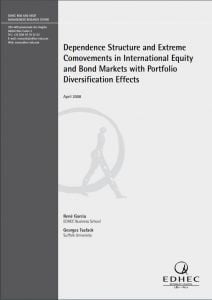

Dependence Structure and Extreme Comovements in International Equity and Bond Markets with Portfolio Diversification Effects
Equity returns are more dependent in bear markets than in bull markets. Previous studies have argued that a multivariate GARCH model or a regime switching (RS) model based on normal innovations could reproduce this asymmetric extreme dependence. This paper shows analytically that it cannot be the case. It proposes an alternative model that allows for tail dependence in lower returns and keeps tail independence for upper returns. This model is applied to international equity and bond markets to investigate their dependence structure. A revisited version of this paper was published in the August 2011 issue of the Journal of Banking and Finance.
Author(s):
Summary:
Equity returns are more dependent in bear markets than in bull markets. Previous studies have argued that a multivariate GARCH model or a regime switching (RS) model based on normal innovations could reproduce this asymmetric extreme dependence. This paper shows analytically that it cannot be the case. It proposes an alternative model that allows for tail dependence in lower returns and keeps tail independence for upper returns. This model is applied to international equity and bond markets to investigate their dependence structure. A revisited version of this paper was published in the August 2011 issue of the Journal of Banking and Finance.
Register to download PDF
Register/Log in| Type : | Working paper |
|---|---|
| Date : | 04/07/2008 |
| Keywords : |
Performance |

